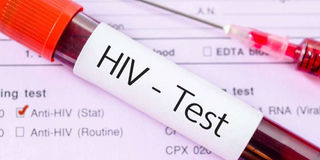Study shows young women’s HIV risk

Women who had their first sexual encounter before the age of 15 faced twice the risk of getting infected with HIV. PHOTO| FOTOSEARCH
The conditions of a first sexual encounter, such as a woman’s age, the man’s age, use of condoms and whether the encounter is consensual can indicate future risk of HIV infection and gender-based violence, new research has shown.
Researchers from the St Michael’s Hospital, University of Toronto, and University of Manitoba in Canada, and Kenya’s National Aids and STI Control Programme (Nascop), found that adolescent girls and young women in Mombasa are more likely to experience higher risks of HIV and gender-based violence, when they have sexual experiences at a young age or when they frequent venues associated with sex work.
Researchers found that adolescent girls and young women who were forced or coerced in their first sexual experience were four to five times more likely to face ongoing gender-based violence throughout their lifetime.
Moreover, one in four participants experienced gender-based violence after their first sexual experience.
Among girls and young women involved in sex work, the prevalence of violence after the first sexual encounter was 38 per cent.
VULNERABLE
Women who had their first sexual encounter before the age of 15 faced twice the risk of getting infected with HIV, and this was especially prevalent for those who were involved in sex work and those who were frequent visitors to places associated with sex work.
“We wanted to understand the early risk and vulnerabilities for HIV because many prevention programmes for key populations reach young sex workers several years after they have already experienced high risk sexual encounters, yet there are vulnerabilities that appear in the first few years of becoming sexually active and entering sex work more formally,” said lead author Dr Sharmistha Mishra.
Key populations include sex workers, men who have sex with men and people who use injectable drugs. These key populations tend to face higher risks of HIV infection because they are involved in high-risk behaviour. They also tend to have higher HIV prevalence than the general population. Interventions to keep HIV infections among these groups are critical in the fight against HIV.
The study drew from a biological and behavioural survey conducted among sexually-active adolescent girls and young women, who were identified at local sex work hotspots, and took a HIV test in addition to the survey.
The research is part of a study designed to count how many young women are involved in sex work in the coastal town. The study also aims to measure their HIV risks, and to understand the impact of not accounting for the early risk of HIV many of these young women face.
"We've identified a need to provide HIV prevention and treatment plans for adolescent girls and young women at an earlier age," said co-author Dr Marissa Becker.
"We hope the findings of this research can assist HIV prevention programmes to adapt their strategies to reach vulnerable young women and teenage girls at a younger age and intervene on risks early on," she added.
The research team is conducting further research to inform the implementation and evaluation of new programmes and interventions.
They are also looking at how their findings, which were published in the Journal of Acquired Immune Deficiency Syndromes (JAIDS), might apply to other countries.


